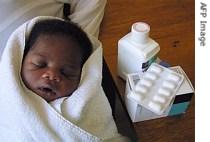2007年VOA标准英语-WHO: More People With HIV/AIDS Getting Treatmen(在线收听)
Geneva
17 April 2007
A new WHO/UNAIDS report shows access to HIV anti-retroviral therapy in poor countries grew significantly in 2006. The report says more than 2 million people living with HIV/AIDS are now receiving treatment. This is a 54 percent increase over the previous year. Lisa Schlein reports for VOA from WHO and UNAIDS headquarters in Geneva.
 |
| A baby sleeps in her mother's arms next to the anti-AIDS drug nevirapine |
UNAIDS official Peter Ghys says more than 1.3 million people in sub-Saharan Africa were receiving treatment in December 2006.
"We notice that there has been a very dramatic increase in access to treatment," he said. "Where it was only two percent three years ago, the treatment coverage has increased to 28 percent by the end of 2006. And this is the most dramatic increase by region."
At the same time, the report notes the goal of providing universal access to comprehensive prevention programs, treatment, care and support is still a long way off. One of the major concerns is providing medicine to pregnant HIV/AIDS mothers to prevent their newborns from getting infected.
World Health Organization care and treatment expert Charlie Gilks says a very small percentage of HIV-positive pregnant women in poor countries are receiving the drugs they need to prevent mother-to-child transmission.
"The report notes that about less than 10 percent of women who are pregnant have received an HIV test as part of their routine antenatal care," he added. "This is one of the reasons why prevention of mother-to-child transmission programs are not moving forward as they should. And, a survey in 12 countries has noted that only 12 percent in sub-Saharan Africa, that only about 12 percent of men and unfortunately even fewer women, 10 percent of women know their HIV status."
Gilks says people who do not know their HIV status are likely not to get access to treatment and stop the infection from spreading.
The World Health Organization says the price of anti-retroviral drugs has gone down about 40 percent, making them more affordable in developing countries. The report notes injecting drug use is a major mode of HIV transmission in several regions. It is a particularly big problem in eastern European countries. However, the report warns that HIV among injecting drug users is emerging as a concern in Africa.